Have you ever stared at a blank page, overwhelmed by the thought of structuring an entire course?
Creating a comprehensive course outline without a structure is like building a house without an architectural plan. But fear not! With the right approach and tools, course outlines become much more manageable. A clear and structured outline is crucial for effective teaching and learning.
This guide will transform you from a course creation novice to a confident knowledge architect.
By the end of this post, you’ll have a solid foundation for building your course content with a course outline template and ensuring your objectives are met and your learners stay engaged.
What Is a Course Outline?
A course outline is a detailed plan that guides instructors and learners through the content and structure of a course. It serves as a roadmap that outlines the key topics, objectives, and activities that will be covered throughout the course’s duration.
A well-crafted course outline ensures that the course content is organized logically, which makes it easier for learners to follow and for instructors to deliver effectively. Essentially, a course outline sets clear expectations and provides a framework for a successful learning experience.
Importance of a Well-Structured Course Outline
Creating well-structured course outlines is crucial for effective learning. I’ve seen firsthand how a well-organized outline sets the tone for what to expect, helping everyone stay on track and achieve their learning goals.
It’s amazing to witness how much smoother and more effective the learning process becomes when you have a clear plan.
1. Clarity and Focus
A clear course outline provides direction. Learners know what topics will be covered and when. This helps them prepare mentally and organize their study time. Instructors benefit, too. They can plan their lessons more effectively, ensuring each session builds on the previous one.
2. Consistency and Progression
Each module follows a logical sequence with a structured outline. This ensures a smooth flow of information, where concepts are introduced, explained, and expanded upon. It prevents confusion and helps learners understand how different parts of the course relate.
3. Measurable Goals
A good outline sets clear objectives for each section. Learners know what they need to achieve by the end of each module. This makes progress measurable and provides a sense of accomplishment as they complete each part of the course.
4. Resource Management
When an outline is well-defined, instructors can prepare the necessary resources. This includes materials, activities, and assessments. It ensures that everything is available when needed, making the learning process seamless and efficient.
5. Engagement and Motivation
Knowing the structure of the course can boost motivation of learners. They can see the journey ahead and understand the purpose of each step. It creates anticipation and encourages active participation as learners look forward to reaching the next milestone.
6. Flexibility and Adaptability
A structured course outline doesn’t mean rigidity. It can accommodate changes and improvements based on feedback and evolving needs. Instructors can tweak the outline to suit the learners better, ensuring the course remains relevant and effective.
Case Study: How CDPI Streamlined Training with ProProfs & Reduced 50% Workload
What Are the Components of a Course Outline?
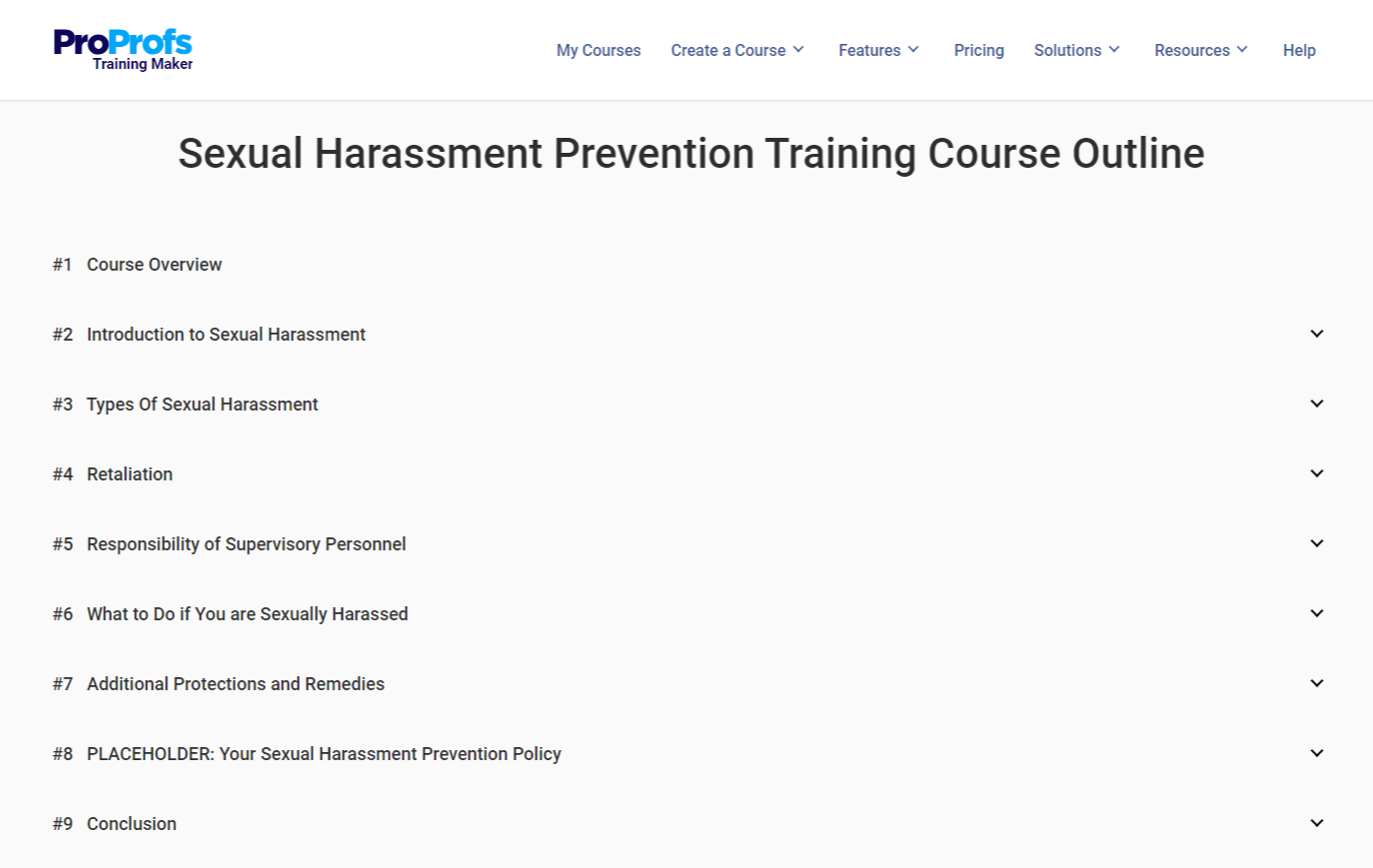
Here are the main components of a course outline:
- Course Title and Description: Clearly state the course title and a brief overview of its content.
- Course Objectives: Define what learners will achieve by the end of the course. These should be specific and measurable.
- Prerequisites: List any knowledge or skills learners need before starting the course.
- Instructor Information: Provide the name, contact information, and office hours of the instructor.
- Course Materials: Include required textbooks, readings, and other resources needed for the course.
- Course Schedule: Break down the course week-by-week or session-by-session, including topics to be covered, assignment due dates, and exam dates.
- Assignments and Exams: Detail the types of assignments, projects, and exams, along with their respective due dates and weight towards the final grade.
- Grading Policy: Explain the grading criteria and the scale used to evaluate learners’ performance.
- Attendance and Participation: State the attendance requirements and how participation will be assessed.
- Course Policies: Outline policies on late submissions, academic integrity, and other important rules.
- Additional Support: Provide information on tutoring services, writing centers, or any other support available to learners.
- Important Dates: Highlight key dates such as holidays, drop/add deadlines, and other significant events during the term.
A well-structured course outline helps you stay organized and focused by providing a clear framework to follow.
How to Create a Course Outline: 10 Proven Steps
Creating an effective course outline has always been a key part of my responsibilities. Here are some tips based on my experience:
- Start With the End in Mind: Define the final goals of the course first. This backward design approach ensures every part of the course aligns with the objectives.
- Include Real-World Scenarios: Incorporate real-world examples relevant to the course content to keep learners engaged and demonstrate the practical application of their knowledge.
- Be Flexible But Structured: Maintain a structured outline while allowing room for adjustments. This flexibility helps address changing needs and enhances the learning experience.
- Create Milestones, Not Just Deadlines: Break the course into structured learning paths, with milestones at the end of each path. This approach allows learners to progress through clear checkpoints to ensure they have mastered key concepts before moving on to the next stage.
- Include Interactive Elements: Embed interactive elements such as quizzes, polls, discussions, and group activities to keep learners engaged and foster a community.
- Gather Continuous Feedback: Collect feedback on specific sessions or topics throughout the course. This ongoing process allows for real-time adjustments to effectively meet learners’ needs.
- Use Visual Aids: Incorporate diagrams, flowcharts, and other visual aids in the course outline to make complex information easier to understand and more engaging.
- Communicate the ‘Why’ Behind Each Component: Explain the importance of each part of the course. Understanding the relevance of the material increases learners’ motivation.
- Provide Multiple Learning Resources: Include a variety of resources like podcasts, videos, and articles to cater to different learning styles and keep the material fresh.
- Provide Reflection Time: Schedule reflection periods where learners can think about what they have learned and how it applies to their goals. This deepens understanding and retention.
Get Free LMS Software — All Features, Forever.
We've helped 567 companies train 200,000+ employees. Create courses in under a minute with our AI LMS or use 200+ ready-made courses on compliance, harassment, DEI, onboarding, and more!
11 Best Course Outline Examples You Must Try
I have been creating examples of my course outline with ProProfs Training Maker. It’s a great tool that makes the process simple and efficient.
Today, I will share a few examples of course outline templates with you. These templates will help you design clear and organized outlines, ensuring your training sessions run smoothly and effectively.
1. IT Onboarding
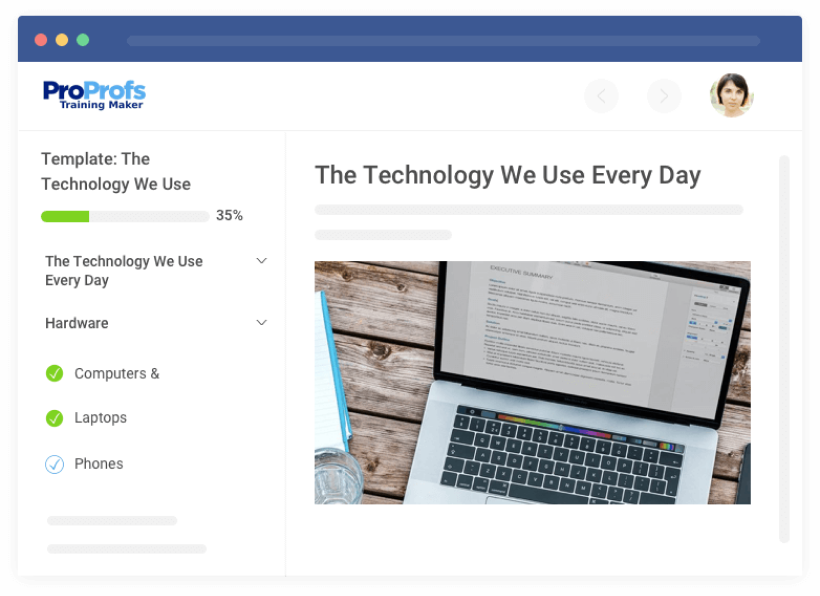
Struggling to equip new hires with the tech know-how they need? Our IT onboarding training template is the antidote to onboarding chaos. It includes training on hardware, software, and tech support. You can easily add text, images, videos, and your company’s branding to the template. This ensures new employees start their jobs well-prepared and productive from the first day.
Using this online course outline template makes training consistent. Each new employee gets the same information, which helps keep standards high across the company. This consistency ensures everyone understands the same key points and makes the workforce more efficient.
The template is easy to customize. You can change it to fit your needs by adding new information or media. It’s also simple to update the design to match your company’s branding. This flexibility helps keep your training current and relevant.
2. Business Training
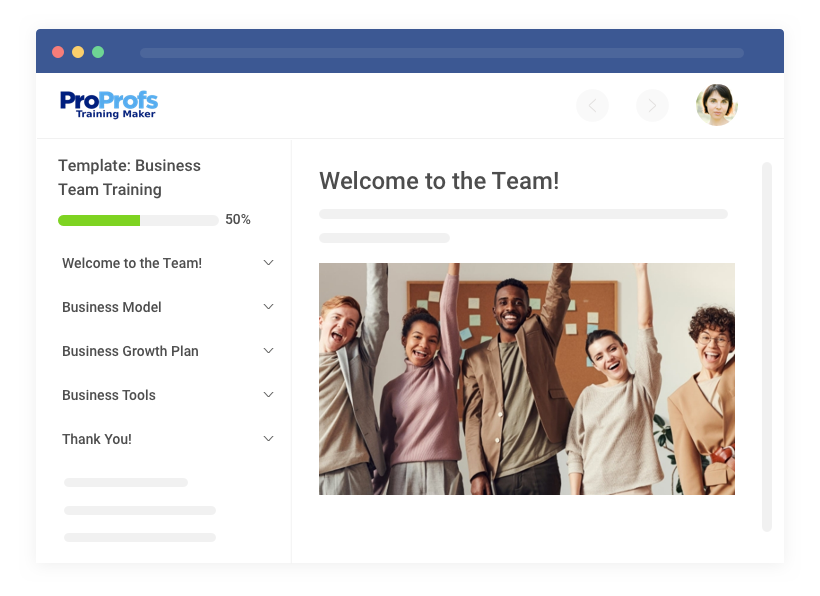
Are you finding it challenging to create engaging business training programs quickly? The business training template can solve this problem. It offers a structured and efficient way to develop courses on business models, processes, tools, products, and growth plans. You can customize it with your company’s specifics and branding, making the training relevant and personalized.
Ensuring consistency in training can be a challenge. This template helps you deliver the same high-quality training to every team member. Using the same template for each training session maintains high standards and clear communication across your organization.
The Business training template saves you time and effort. You can quickly update and reuse the template for different training needs, reducing the time spent on course creation. This efficiency lets you focus on other critical tasks while ensuring your team is well-trained.
3. Sales Training

Designed by experts, this sales training template covers key sales topics like prospecting, inbound sales, cold calling, and customer service. You can customize it with your company’s specifics and add images, videos, and branding. This ensures the training is both engaging and relevant.
Consistency is key in training. This template guarantees that every new sales team member receives the same high-quality training. By using the same template for each session, you ensure clear communication and maintain high standards across the board, which helps build a strong, knowledgeable sales team.
Time and cost are important factors in training development. This template saves you both. It eliminates the need to create training materials from scratch, allowing you to update and reuse the template quickly. This efficiency means you can spend more time focusing on other critical tasks.
I have also tried a few of the readymade courses. You can check them out as well:
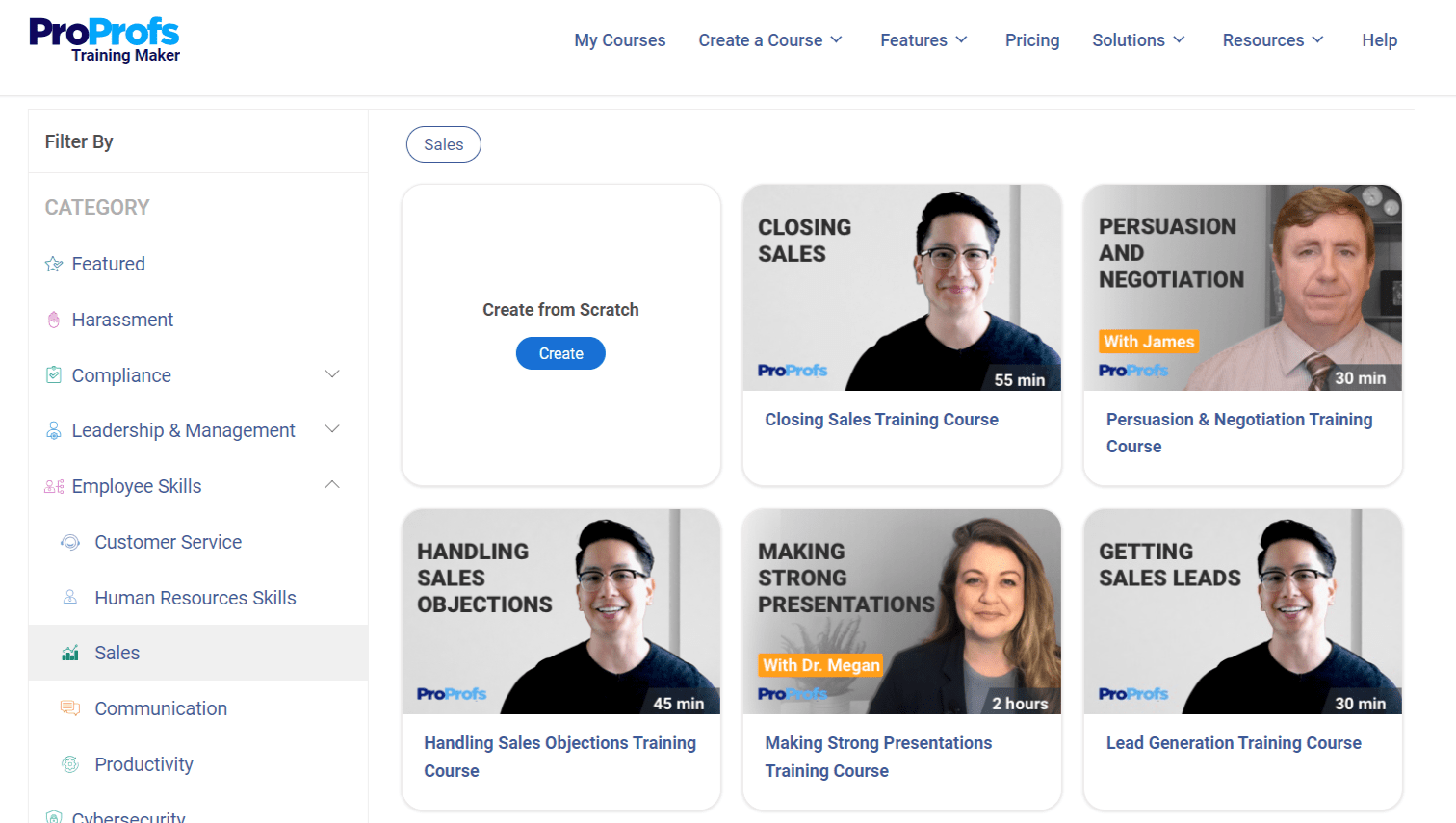
4. Finance Training

Ditch the financial training headache! This template, crafted by industry veterans, covers the financial bedrock: corporate finance, accounting, expenses, invoicing, and forecasting. But it’s not just a template; it’s your canvas. Inject your company’s personality with custom text, vibrant images, and engaging videos.
Consistency breeds excellence. Deliver uniform, high-quality training across your organization and watch your finance team soar. No more knowledge gaps or training inconsistencies.
Say goodbye to time-consuming training material creation. This template is your efficiency booster. Focus on strategic financial moves while the template handles the training essentials. Flexible and adaptable, this template empowers your team to learn at their own pace. It’s like having a personal finance tutor, accessible anytime, anywhere.
5. Communication Training

Designed by industry experts, this template covers key topics like communication team structure, internal and external communication plans, and communication tools. It’s easy to customize with your company’s details, images, videos, and branding. This template ensures consistent training.
Using the same structure for each session maintains high standards and clear communication across your organization. This helps build an effective communication team. The template saves time and costs. It reduces the effort needed to create training materials from scratch. You can update and reuse the template quickly, letting you focus on other tasks while still providing quality training.
The online course outline template works on all devices, including smartphones, tablets, laptops, and PCs. With this tool, you can create professional online training courses without needing software installation or coding knowledge. You can track learner progress, automate grading, and issue custom certificates upon course completion.
6. Marketing Training
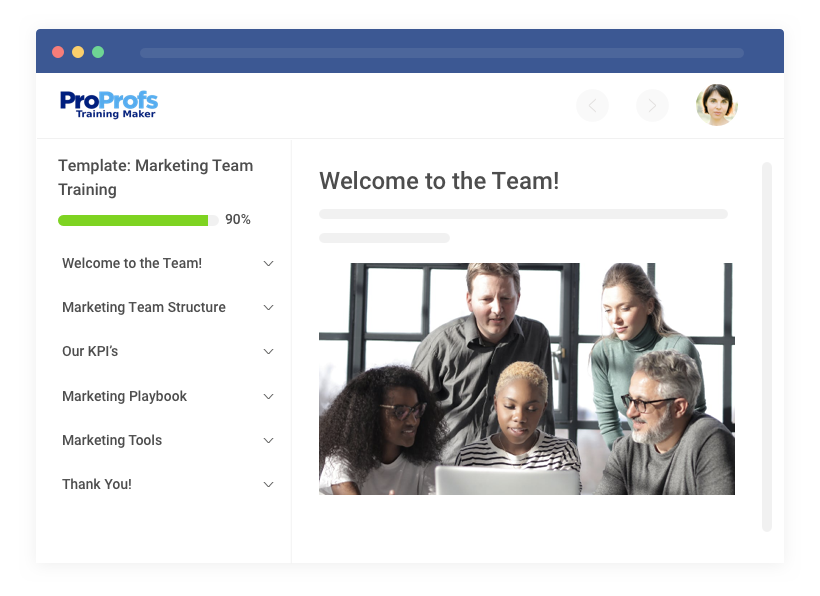
I appreciate the comprehensive layout of this marketing training template. It covers crucial topics such as team structure, KPIs, and marketing tools and ensures a holistic training experience for any marketing team.
I appreciate the accelerated course creation feature. The pre-built outline allows us to add our content quickly, which is ideal for organizations looking to launch training programs without delay. The customization options enhance the flexibility of the templates. We can tailor the template to meet specific training needs, adding branding elements and updating content as required, making it adaptable and relevant.
Consistency in training delivery is invaluable. By using a standardized template, we ensure that all team members receive the same high-quality training. This helps maintain uniformity and enhances the overall effectiveness of our training programs.
7. First Aid Training
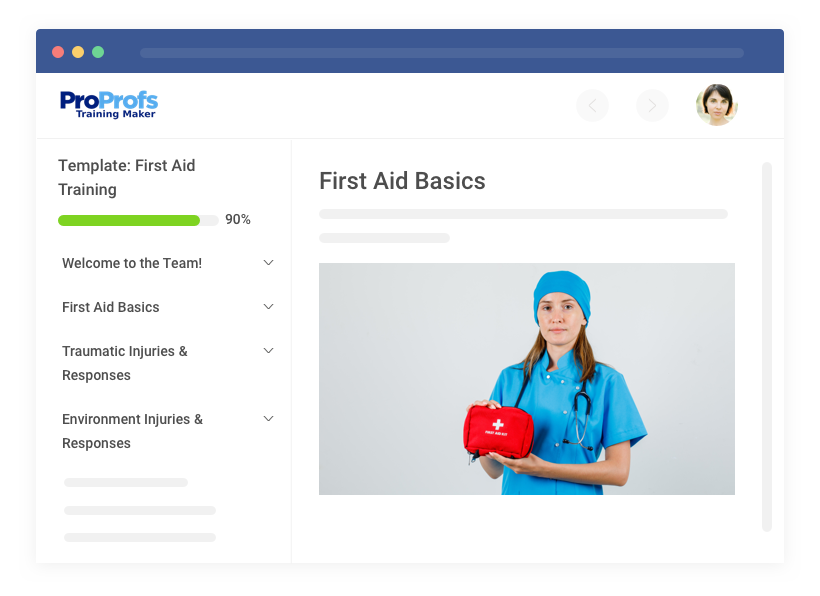
First aid training is something you can’t afford to overlook. It’s your lifeline in an emergency, the knowledge that could mean the difference between life and death. This course outline template is the answer! It covers essential topics such as scene safety assessment, handwashing, and traumatic injuries.
One of the standout features is the ease of customization. You can quickly add, edit, or delete content to fit your training needs. Personalizing with images, videos, and other multimedia enhances the learning experience, making the training more interactive and effective.
Another advantage is the compatibility with various devices and browsers. Learners can access the training anytime, anywhere, which is crucial for modern learning environments. The template saves time and costs associated with course development. It’s a valuable tool for any organization looking to implement an effective first-aid training program.
8. Employee Training
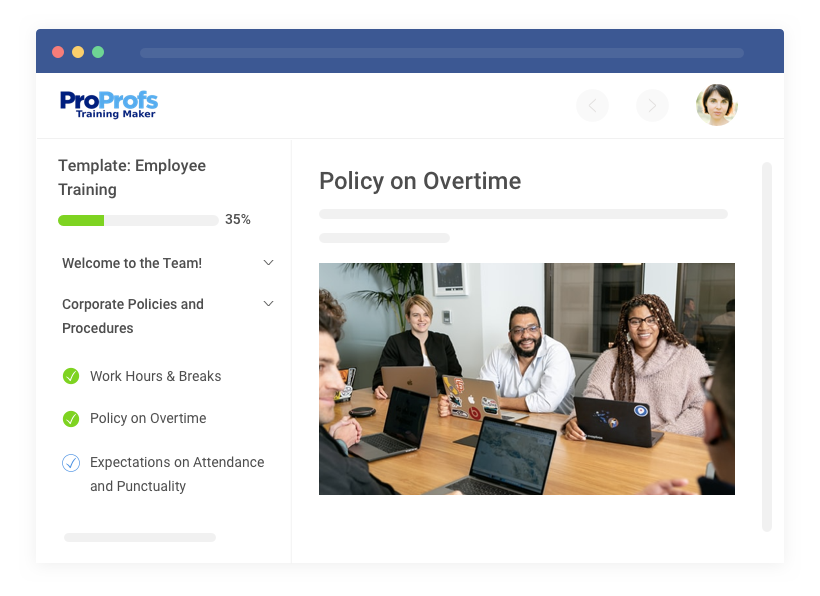
This course outline is of great help because it offers a structured and efficient way to create and deliver training programs. The template ensures that all essential topics, from corporate policies to specific skill training, are covered and provides a consistent learning experience for employees across different departments and roles.
Moreover, the course outline enhances customization and flexibility that enable organizations to tailor the content to their needs. Whether updating the company’s latest policies or adding new training modules, this training course outline allows easy modifications without requiring extensive time or technical expertise.
Lastly, the ability to track learner progress and assess the impact of training through advanced reporting features adds significant value. This functionality helps identify areas where employees may need further development and ensures that training objectives are met.
Here’s a quick tutorial on: How to Create Employee Training Courses Online
9. Customer Service Training
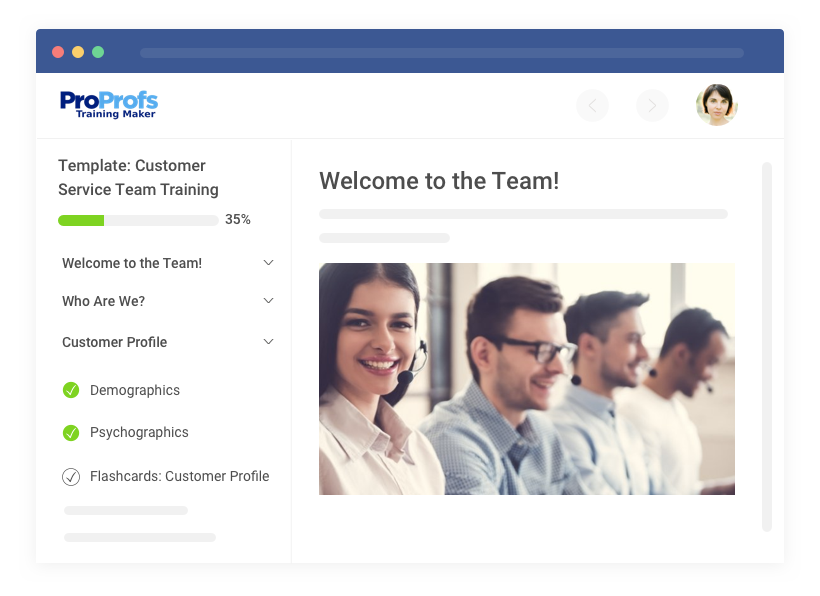
Another course outline template I’d recommend is Customer Service Training. This customer service training course outline is a fantastic tool for any business looking to improve customer service. It’s designed to make creating training programs easy and effective. Furthermore, it covers important topics like understanding customer needs, service etiquette, and communication skills.
One of the best things about this outline is how easy it is to customize. You can tweak the content to fit your company’s needs, add videos, images, or even your company’s branding to make the training more engaging.
The outline also comes with smart tools to track how your team is doing. You can see who’s completed the training, how well they’re understanding the material, and where they might need extra help.
10. Leadership Training

The leadership training course template is an excellent resource for businesses looking to develop strong leaders within their organizations. This template, designed by industry experts, covers essential leadership topics like goal setting, strategic initiatives, and effective management.
It’s perfect for creating engaging and effective training courses that can help build a capable leadership team. With this template, you can quickly create courses to share with your team, ensuring consistent and high-quality training across your organization. You can easily add your own content, images, videos, and branding to make the training more relevant and engaging for your team.
This template allows you to update the course content, add new chapters, or personalize the look and feel with minimal effort. The smart reporting features also allow you to track progress, assess knowledge retention, and gather feedback to continually improve your training programs.
11. Technical Training Course
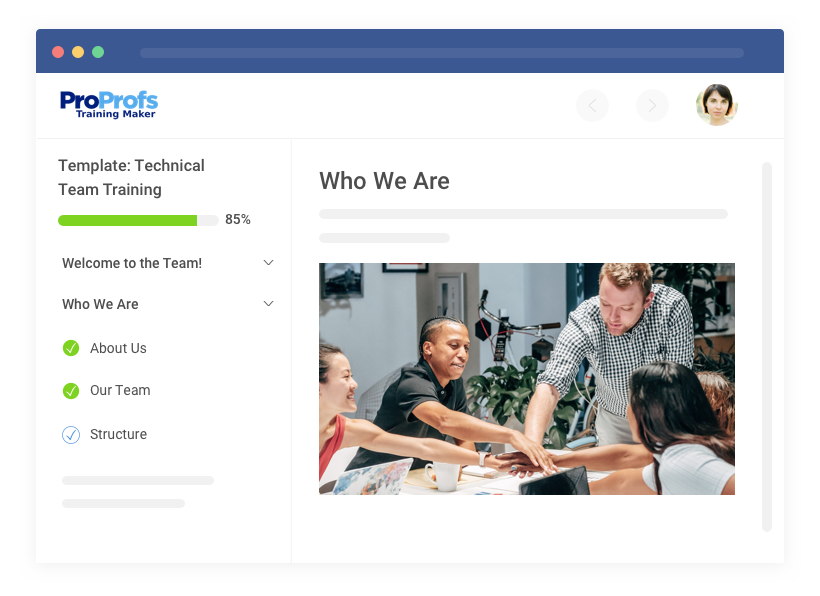
This is the last course I’d like to add to this list, and it’s a must-have for any business that values well-trained, technically proficient employees. It’s designed to help you create effective, engaging technical training courses that are easy to customize and develop quickly. Whether you’re training employees in IT, engineering, or any other technical field, this template gives you a solid foundation to build on.
The template also makes it simple to keep your courses engaging by allowing you to embed quizzes, surveys, and polls. Plus, the template is designed to work across all devices and browsers, so your team can access the training anytime, anywhere, making learning flexible and convenient.
Using this template will save you time and money. It streamlines the course creation process and reduces the need for extensive development. It also ensures consistency in your training, as you can use the same template to deliver high-quality content to different teams across your organization.
Ready to Create a Course Outline?
Creating a well-structured training course outline is the cornerstone of effective teaching and learning. It’s your roadmap to success, ensuring clarity, engagement, and measurable outcomes. By following the steps outlined in this guide and using the provided course outline templates, you’ll be well-equipped to design courses that captivate learners and deliver exceptional results.
Remember, a course outline is a dynamic document. It’s essential to gather feedback from learners and make adjustments to enhance the learning experience. Continuously evaluate and refine your outlines to ensure they remain aligned with your course objectives and the evolving needs of your learners.
Are you ready to transform your course planning process?
Frequently Asked Questions
What should be included in a training outline?
A training outline should include key objectives, topics covered, methods of instruction, materials needed, and assessment plans. It should clearly map out the course structure, detailing what will be taught and how it will be delivered to meet learning goals.
How can I use a course outline?
You can use a course outline to stay organized and ensure all key topics are covered. It serves as a roadmap, helping you plan lessons, track progress, and effectively meet the course objectives.
How can learners use a course outline?
Learners use a course outline to understand what will be covered in the course. It helps them prepare for classes, track their progress, and know what is expected of them, ensuring they stay on track with their learning goals.
Are there any specific guidelines for creating an online course outline?
When creating an online course outline, include clear learning objectives, a logical sequence of topics, interactive elements, and deadlines. Consider online tools and platforms for delivery, ensuring the content is accessible and engaging for remote learners.



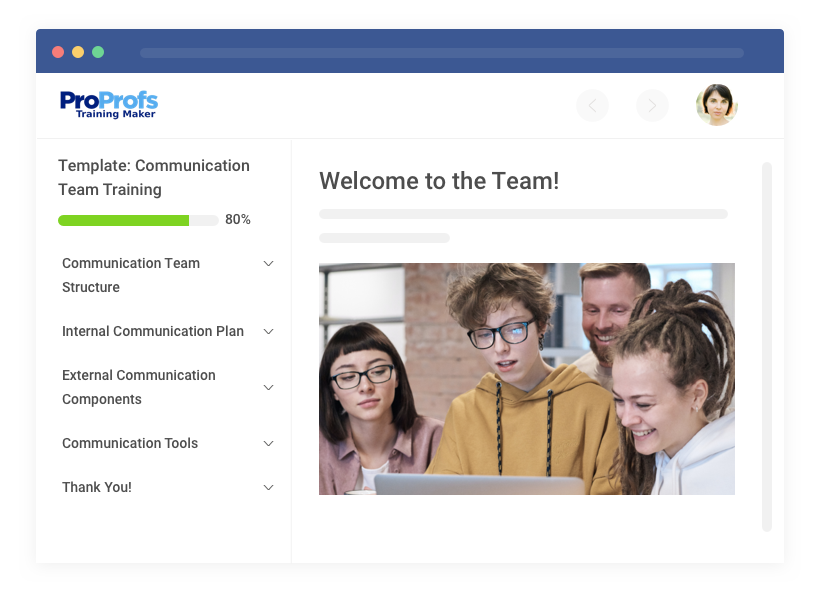
 We'd love your feedback!
We'd love your feedback! Thanks for your feedback!
Thanks for your feedback!








